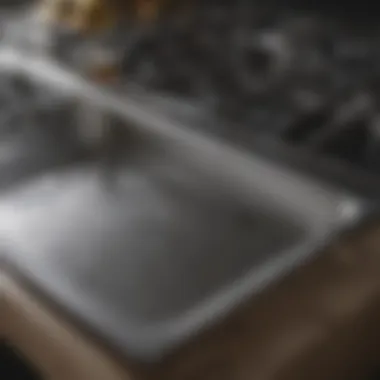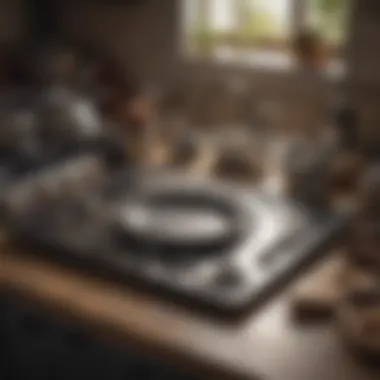Essential Guide to GE Stove Drip Pans for Maintenance


Intro
Overview of Topic
Stove drip pans are more than simple accessories in the kitchen. They play a fundamental role in maintaining both the efficiency and safety of GE stoves. These pans are positioned beneath the burners to catch drips, spills, and food particles that can fall while cooking. Over time, heat and food residues can lead to various issues in these pans, which, if not addressed, may impact the performance of the stove itself.
The importance of regularly maintaining drip pans extends beyond aesthetics. They prevent unwanted odors from permeating the kitchen, reduce the risk of grease fires, and enhance the overall cooking experience. Homeowners and chefs who prioritize cleanliness and safety notice a marked difference in their cooking efficiency and smell. Thus, understanding the maintenance of these pans is key to any home improvement strategy.
Common Challenges and Solutions
When it comes to managing stove drip pans, several common challenges arise for homeowners:
- Buildup of Grease and Food Debris: Over time, grease can accumulate, leading to unpleasant smells and potential fire hazards.
- Warping or Discoloration: High temperatures may cause pans to warp, reducing their effectiveness and necessitating replacement.
- Difficulties in Cleaning: Some materials are hard to clean, resulting in the need for frequent replacements.
Solutions and Tips
To combat these challenges, several strategies are advisable:
- Regular Cleaning: Make a routine of cleaning drip pans after major cooking events. Soaking them in warm, soapy water can loosen built-up food residues.
- Use the Right Materials: Opt for drip pans made of durable materials like stainless steel or enameled surfaces that withstand heat.
- Replacement vs. Repair: If the pan is warped or severely stained, it is best to replace and not try to salvage them, as this can lead to bigger issues down the line.
Product Recommendations
When selecting stove drip pans, it’s essential to choose high-quality products that promise durability and effectiveness. This section will look at notable options available in the market:
- GE Appliances Drip Pan: Specifically designed for GE stoves, these pans provide a perfect fit. They are heat resistant and easy to clean, making them a popular choice.
- Cuisinart Stainless Steel Drip Pan: This option offers excellent durability and can withstand aggressive cooking.
- Frigidaire Drip Pan Set: Known for its ease of installation, it perfectly captures drips and helps maintain clean cooking surfaces.
Homeowners should consider the benefits of owning wide, durable pans that are also stylish to make the cooking experience more pleasing.
Step-by-Step Guides
Implementing improvements in this area is not daunting with a clear plan. Here is a simple guide to managing your stove drip pans effectively:
- Choose the Right Pan for Your Model
- Installation
- Regular Maintenance
- Check your GE stove’s manual or measurements.
- Purchase from a reputable seller.
- Ensure the stove is off and cool before changing pans.
- Remove the current pan by lifting it straight up and off.
- Place the new pan in the same location where the old one was.
- Schedule cleaning days after high-use periods.
- Use non-abrasive materials to scrub the pans and avoid scratches.
Keeping oral recaps detailed ensures no critically important measures for good maintenance of drip pans are missed.
"A well-kept drip pan not only enhances the stove efficiency but also elevates the entire kitchen experience."
By merely focusing on these practical pointers and insights, homemakers can simplify their kitchen cleaning routines and devote more time to what truly matters—good cooking and wonderful family interactions.
Prelude to Stove Drip Pans
The significance of stove drip pans cannot be understated. They are essential components in any kitchen. Particularly for GE stoves, these little accessories provide necessary protection to the stove itself. Their main role is to catch spills and crumbs that can fall while cooking. This not only keeps the stove clean but also prevents unwanted messes that might create hazards.
Definition and Purpose
Stove drip pans are typically shallow, removable dishes placed under the burners of a stove. They are designed to catch food spills and cooking debris. Made from various materials like aluminum, enamel, or steel, these pans serve vital functions. They help maintain the stove's cleanliness and can also enhance overall cooking efficiency. When properly utilized, drip pans absorb excess heat and distribute it evenly around the burner. While many might view them merely as simple accessories, they play a pivotal role in ensuring both performance and safety in everyday cooking.
Importance of Regular Maintenance
Maintaining stove drip pans is crucial for both hygiene and safety. Over time, spills can promote the growth of bacteria or mold, making regular cleaning mandatory to avoid health issues. As time passes, uncleanly maintained pans can also experience damage and may even affect the working of the burners. Additionally, well-maintained drip pans contribute to better energy efficiency during cooking.
"The old saying 'a clean kitchen is a happy kitchen' rings especially true when it comes to stove drip pans." Regular upkeep can make cooking a much more pleasant experience.


In summary, addressing the maintenance of GE stove drip pans goes beyond aesthetics. It is about fostering a safe cooking environment while ensuring the longevity of the appliance.
Types of GE Stove Drip Pans
Understanding the various styles of GE stove drip pans is crucial for maintaining kitchen efficiency and safety. Different types offer distinct features and cater to specific cooking needs. Choosing the right type influences factors such as durability, ease of cleaning, and overall performance. In the sections below, we’ll delve into three major types of drum pans, highlighting their benefits and considerations.
Standard Drip Pans
Standard drip pans are the most commonly used type. They are generally made from stainless steel or similar materials, offering a balance between resistance to heat and ease of cleaning. The main advantage of standard pans lies in their simplicity and availability. They fit most GE stoves without complication.
Key Benefits:
- Cost-Effective: Standard drip pans are usually affordable and readily accessible at local stores.
- Easy to Clean: Their surface allows for straightforward cleaning, minimizing cooking residue buildup over time.
However, regular usage can lead to issues such as warping. Maintaining vigilance when observing shifts or misshapen areas is necessary to ensure proper heat distribution.
Aluminum Drip Pans
Aluminum drip pans are another viable option for GE stoves. Known for their lightweight nature, aluminum pans promote efficient heat distribution, which is beneficial for even cooking. They are often sold as disposable options, making them convenient for those seeking minimal maintenance.
Benefits to Consider:
- Good Heat Conduction: Aluminum quickly heats up and cools down, aiding in better energy efficiency.
- Lightweight: Their design simplifies the handling and changing processes.
Nevertheless, aluminum pans may become discolored over time. Their tendency to scratch makes gentle cleaning methods necessary. Moreover, they can be prone to warping if subjected to extreme temperature fluctuations.
Enamel-Coated Drip Pans
Enamel-coated drip pans offer an appealing balance between aesthetics and practicality. These pans are often ceramic or steel coated with an enamel finish that comes in various colors. Their smoother surface not only provides ease of cleaning but also adds a pop of color to the kitchen.
Practical Aspects to Keep in Mind:
- Enhanced Durability: The enamel finish provides a protective layer against scratches and stains, resulting in a longer lifespan when properly maintained.
- Variety in Design: These pans often come in various colors, enabling personalization in kitchen decor.
Nonetheless, caution should be observed when using metal utensils, as they can easily chip or scratch the enamel. Regular inspections for cracks will improve longevity and, consequently, safety.
Always choose a drip pan based on both functionality and aesthetic preferences to create an efficient cooking space.
Functionalities of Stove Drip Pans
Stove drip pans, often overlooked, play a crucial role in both the performance and longevity of GE stoves. These components serve multiple functionalities that contribute significantly to the overall experience in the kitchen. Understanding these functionalities sheds light on why they should be an integral part of stove maintenance.
Heat Distribution
One of the primary purposes of stove drip pans is enhancing heat distribution. When cooking, it's essential for the heat to be uniformly distributed across the surface of the cookware. Solid drip pans are particularly effective in this regard. They distribute the heat from the burner evenly, preventing hot spots that can create inconsistent cooking conditions. For those preparing elaborate meals, this is key, as uneven heating can alter cooking times and damage certain types of cookware.
Additionally, an effective heat distribution prevents overheating, which can cause food residues to burn onto the pans. This helps in maintaining a cleaner cooking environment, thus facilitating easier clean-up after meal preparation. Regular usage of stove drip pans can extend the lifespan of both the cookware and the modular stove components, an often unrecognized benefit.
Catch Spills and Drips
Another essential functionality of stove drip pans is their ability to catch spills and drips. When cooking with liquids or overly hearty mixtures, it's common for spills to occur. These pans create a barrier that contains accidental spills or drips, keeping them off the heating elements and stovetop. This not only helps in cleanliness but also reduces fire hazards associated with leftover food particles on burners.
The presence of drip pans also supports a healthier cooking environment by minimizing the chances of burns or production of unpleasant smoke from cooking spills that catch fire.
Moreover, without well-placed drip pans, irregular cleanup could lead to the residue buildup around burners. This situation not only promotes bacterial growth but may also impede the proper functioning of the stove. By catching spills in a designed area, they make the overall cooking process more convenient and secure, which is particularly valuable for householders preparing meals in a busy kitchen.
In summation, the functionalities of GE stove drip pans extend beyond mere support for cookware. They provide benefits in heat distribution and spill management. Implementing a thorough understanding of these functionalities allows housewives and home owners to optimize their kitchen experience, ensuring that they can give quality attention to their cooking and savor the results with satisfaction.
Common Issues with GE Stove Drip Pans


Understanding the common issues with GE stove drip pans is crucial for maintaining kitchen efficiency and safety. Since these components play a role in capturing spills and ensuring heat distribution, any malfunction directly impacts cooking performance. Being aware of the problems that can occur provides users the knowledge to address them promptly, enhancing both the lifespan of the drip pans and the performance of the stove itself.
Warping and Discoloration
Warping occurs when the drip pans are exposed to extreme heat over time. The heat can compromise the structural integrity of the metal, causing them to lose their flat shape. Discoloration can result from both prolonged exposure to heat and the chemical reaction with various food spills. It is important to inspect drip pans regularly for these issues.
To avoid warping and discoloration, consider these practices:
- Use appropriate cookware that fits in your stove and not too heavy.
- Avoid exposing empty pans to high heat.
- Regularly check for any signs of distress in the drip pans to catch issues earlier.
Rust and Corrosion
Rust can be a significant concern if the drip pans are soaked in water or other liquids without prompt drying. Washing drip pans with abrasive cleaning tools can strip protective coatings, making them vulnerable to moisture. Over time, this can lead to corrosion, which can affect both appearance and functionality.
To prevent rust and corrosion, adhere to the following measures:
- Immediately and thoroughly dry drip pans after general cleaning.
- Use mild non-abrasive cleaners to maintain surface integrity.
- Store only when completely dry to inhibit rust development.
Sticking and Residue Buildup
Sticking and residue buildup often stem from burnt food, grease, or other oily substances. When not addressed timely, this can lead to stubborn stains that are difficult to remove. More significantly, debris can hinder heat distribution and subsequently affect how evenly food cooks. Keeping drip pans clean can prevent these issues and improve overall cooking performance.
To minimize sticking and ensure cleanliness:
- Clean drip pans regularly after use.
- Allow them to soak in warm soapy water briefly for easy cleaning.
- Consider using non-stick products where possible, but ensure they are compatible with your stove.
Maintaining clean and functional drip pans not only prolongs their life but also promotes effective cooking in the kitchen. Being aware of the issues that can arise and implementing preventive measures is key to achieving this.
By being attentive to these common issues—warping, rust, discoloration, and residue—the GE stove drip pans can continue serving their vital function well into the future.
Installation of GE Stove Drip Pans
Installation of stove drip pans is an often overlooked aspect of kitchen maintenance. Their role is critical in ensuring both functionality and safety in using GE stoves. A proper installation process minimizes issues such as spills, burns, and inefficiencies. Furthermore, it directly aids the kitchen's cleanliness and the appliance's longevity.
Step-by-Step Installation Guide
To install GE stove drip pans correctly, follow these steps:
- Turn Off the Stove: Ensure that the stove is completely turned off to prevent any risks.
- Remove the Existing Drip Pans: Gently lift the old drip pans out from their designated spots. This may require a slight wiggle, as residue could cause them to stick.
- Clean the Area: Take a moment to wipe down the area approximately where the drip pans sit. Use a damp cloth to eliminate food residues or dust.
- Position the New Drip Pans: Place the clean drip pans into their specific slots, ensuring a snug fit. There should be no gaps present. This is key for appropriate heat conduction.
- Secure the Burners: If the stove has removable burners, replace these after the drip pans are in position, ensuring everything is correctly lined up.
- Test the Area: Before using the stove, ensure everything is secure. A light touch can affirm proper fit. Check for stability.
Following this guide simply allows for efficient stove operation, preserving both appliance integrity and kitchen aesthetics.
Tools Required for Installation
Although the installation of GE stove drip pans can be carried out with minimal tools, having a few specific items may make the job easier:
- Screwdriver: For loosening any handles or parts if the burners need more access.
- Cleaning Cloth: Use this to clean the stove area before installing new drip pans.
- Replacement Drip Pans: Ensure these are specifically compatible with your model for proper fitting.
These tools are usually readily available in most homes. They streamline the entire process, emphasizing that good preparation aids significantly in maintenance tasks.
Maintenance Tips for Stove Drip Pans
Maintenance of stove drip pans is crucial not only for the longevity of the pans themselves, but also for the overall performance and cleanliness of the stove. Regular care ensures that the pans function as intended, reduce the risks of grease fires, and maintain the aesthetic appeal of the kitchen. Moreover, the importance of employing specific cleaning methods cannot be overstated, as residues can harden over time and become challenging to remove, thereby complicating the clean-up process undertaken while cooking.
Maintaining central focus on stove drip pans helps keep the cooking environment safe and efficient. The tips discussed here can mitigate potential issues and extend the lifespan of your GE stove components.
Regular Cleaning Practices
To maintain the efficacy of GE stove drip pans, cleaning should be frequent and thorough. Food residues and grease can not only affect flavor but may also lead to smoke and flares when heat is applied during cooking.


- Frequency of Cleaning: Ideally, wipe down the drip pans after every cooking session. Once a week, perform a deep cleaning with mild detergents.
- Cleaning Solutions: For an effective wash, consider using vinegar and baking soda. These natural products can dissolve grime without harsh chemicals.
- Scrubbing Tools: Use non-abrasive sponges. Abrasions can lead to scratches that may reduce the effectiveness of the pan over time.
- Drip Pan Removal: Carefully remove the pans and ensure that any stuck food pieces are loosened before soaking in soapy water for approximately 20 minutes.
Remember that consistent cleaning not only prevents buildup but also allows for a pleasant cooking experience with no burnt odors while using your GE stove.
Preventive Measures Against Damage
Preventing damage entails various strategies that work together to safeguard the integrity of your stove drip pans. Proactive measures ensure that the pans remain in optimal condition and serve their purpose effectively.
- Avoid Overheating: High heat settings can warp the pans. Use medium heat whenever possible to prevent deformation.
- Proper Placement: Ensure that the pans are placed correctly during installation. Misalignment can create wobbling that can damage both the pans and the stove rig.
- Dust Covers: Whenever the stove is not in use, consider covering it with a clean cloth to avoid dust accumulation and potential scratches.
- Careful Handling: When cleaning or replacing the pans, handle them with care to avoid any bending or breaking.
By adopting dedicated maintenance practices and preventive measures, you can significantly enhance the functioning and durability of your GE stove drip pans.
Replacement Options for GE Stove Drip Pans
Choosing the right replacement options for GE stove drip pans is essential. This section outlines the critical aspects of why and when to make a change, as well as how to select the most suitable replacements. Understanding these elements will enhance stove maintenance, especially in ensuring efficiency and safety during cooking.
When to Replace Drip Pans
The timely replacement of drip pans can substantially impact kitchen hygiene and appliance performance. Signs that indicate a need for replacement include:
- Visible damage: Cracks or dents can compromise the effectiveness of the pan.
- Extreme discoloration: If your drip pans are warped or tarnished, they may not function properly anymore.
- Repeated cleaning frustration: If residue builds up no matter how diligently you clean, it may be best to replace them.
- Food safety concerns: Old or damaged drip pans can contribute to uneven heating and potential food contamination.
To maintain peak performance of your GE stove, consider a replacement every two to three years, or sooner if signs of wear appear.
Choosing Compatible Drip Pans
Selecting the right replacement drip pans involves several considerations to make sure they fit your GE stove properly. Look for pans that explicitly state compatibility with your stove model. Factors to keep in mind include:
- Material type: Depending on your cooking style, you may prefer aluminum for fast heating or enamel-coated pans for ease of cleaning.
- Size and shape: Compare the dimensions of your current pans with any potential replacements to ensure a secure fit.
- Quality: Investigate options from reputable manufacturers to guarantee durability.
- Manufacturer specifications: Refer to GE stove guidelines or manuals to avoid incorrect purchases.
Remember to choose drip pans that not only fit but also cater to your cooking habits, giving you the best possible cooking experience.
Sustainability and Eco-Friendly Choices
Stove drip pans often serve as unsung heroes in kitchen maintenance, yet their sustainability is an area worth examining. Sustainability is becoming increasingly important in today’s environmentally-aware society. The continued use of stove drip pans and the materials from which they are made can have significant impacts on both the environment and kitchen efficiencies. Addressing sustainability encourages homeowners to resonate with practices that not only lower their carbon footprint but also provide long-term benefits in terms of efficiency and savings.
A focus on eco-friendly choices allows consumers to choose materials and practices that minimize waste and energy consumption. Evaluating the lifecycle of the materials used in drip pans can lead to choices that promote recycling and reduce overall environmental impact.
Recyclable Materials
Choosing recyclable materials for stove drip pans is a step towards creating an eco-friendlier kitchen. Most modern drip pans are designed with recyclability in mind. Materials such as aluminum and certain types of coated steel can be recycled after their lifespan has ended. By opting for pans that are labeled as recyclable, homeowners can contribute to a circular economy. This entails preventing unnecessary waste from landfills, which benefits the environment.
Here are some recyclable materials to consider when selecting drip pans:
- Aluminum: Lightweight, resistant to corrosion, and can be recycled repeatedly without quality loss.
- Certain Steel Types: Steel is often recyclable, provided it is free of chemicals or non-recyclable coatings.
- Natural Coatings: Some coated pans are made with environmentally safe materials that can breakdown safely.
It is essential for consumers to check local recycling guidelines, as some materials may not be accepted everywhere. Finding eco-friendly distributors or products can often be supported through local community work or checking resource lists online.
Impact of Drip Pans on Energy Efficiency
Drip pans play a surprisinly sizeable role in the energy efficiency of stoves. Using quality drip pans, especially those designed for particular stove models, can mean more efficient heat distribution. When heat is not wasted due to exceeding recovery time and escaping residues, ovens become more economical in energy usage. Efficient heating can lead to lower utility bills and a reduced environmental impact.
Moreover, maintaining frequency in the form of clean and effective drip pans helps contribute to a more energy-savvy cooking experience. Residues can heat unevenly and impact the overall performance of the stove. Hence, incorporating practices that support the longevity of efficient drips pans becomes not only a matter of device upkeep but a larger commitment to energy sustainability.
Culmination
In this article, examining GE stove drip pans reveals their crucial role in maintaining kitchen cleanliness and optimizing cooking safety. Drip pans serve not only as practical tools for managing spills and enhancing heat distribution but also as essential components in the overall longevity of the stove. Regular checks and maintenance ensure that these parts perform their best.
The significance of stove drip pans incorporates several elements that housewives and homeowners should consider. Their simplicity belies their importance; however, neglected or damaged drip pans can lead to larger issues, including unsafe cooking conditions and compromised appliance functionality. Thus, understanding when to replace or maintain these components is vital.
"Drip pans are integral to stove performance and kitchen cleanliness. Ignoring them can lead to safety hazards during cooking."
Key Takeaways
Consistent care of GE stove drip pans impacts kitchen safety. Here are main takeaways:
- Functionality: Drip pans protect the stove interior from messy spillages.
- Material Matters: The choice of material — whether aluminum, enamel-coated, or standard — can significantly affect longevity and utility.
- Maintenance Is Key: Regular cleaning removes sticky residue, preventing further damage and during meal prep.
- Replacement Knowledge: Timely replacements when pans are warped or discolored enhance both safety and cooking efficiency.







